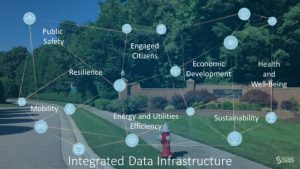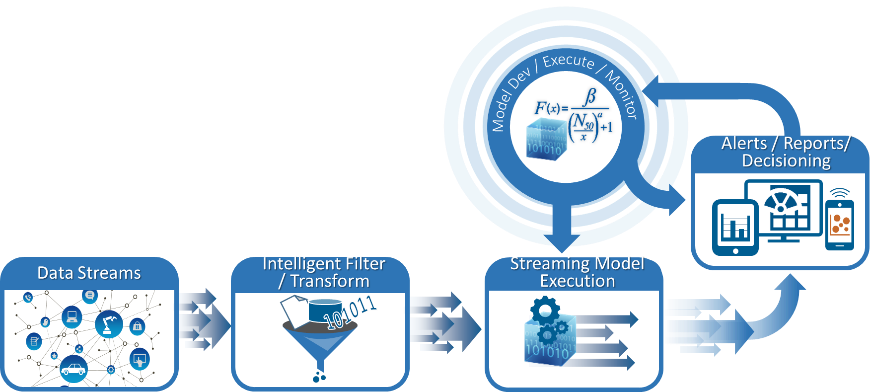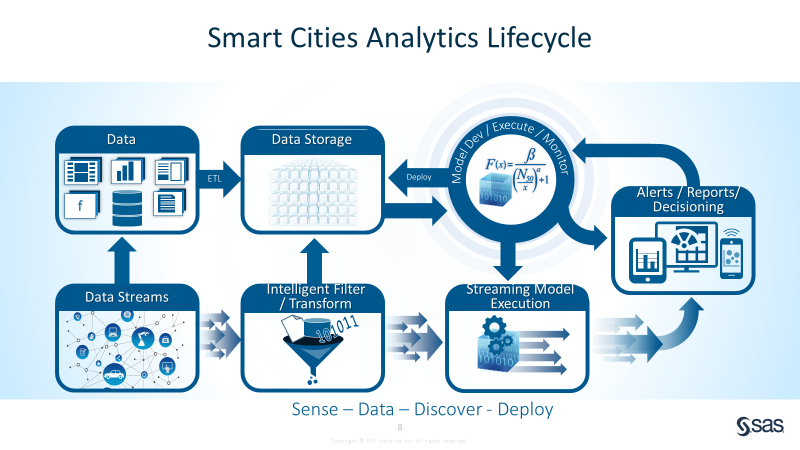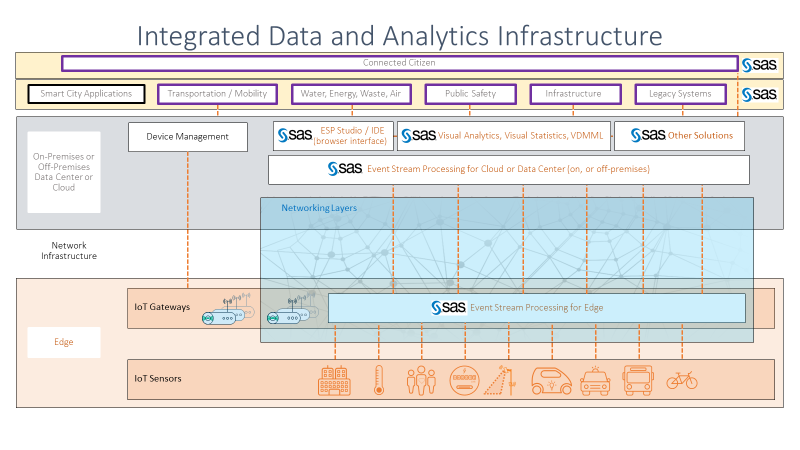I have lived in the Town of Cary for more than twenty years; two of my three children were born at the local WakeMed Cary Hospital. I’m a big fan of my city, or town as it prefers to be called – even though the population is over 160,000.
That’s why it was so exciting when the Smart Cities Council awarded the town with a 2018 Readiness Challenge Grant. Recently, SAS hosted about 80 town officials, employees and Smart City Council partners, including SAS, in the Smart Cities Council Readiness Workshop. Local media covered the event.
The Town of Cary identified three initiatives for collaboration with the Readiness Workshop participants:
- Smart, safe mobility.
- Healthy communities.
- Integrated data infrastructure.
I provided the town with a solution overview for the Integrated data infrastructure (IDI) initiative, starting with a picture I took of my neighborhood for my introduction.

The goal of the IDI initiative is to figure out how the town can provide relevant real-time information across the various town agencies and departments, create a 360-degree view of its citizens, and integrate their existing smart city initiatives and projects with new projects as they arise.
Why should we care about smart cities?
Many of the technologies enabling smart cities can seem distant and utopian. But the goal of having a livable, workable and sustainable city can have broad-reaching impacts to citizens in their every day life. For example, smart streetlights and parking sensors can improve traffic and commute times. Smart mobility solutions can provide door-to-door transportation for everyone, reducing pollution, congestion and saving time, money and energy. Wearable sensors for those at risk for health incidents can help the city dispatch emergency responders quickly. The overarching goal of smart city technology is to provide ways that make city-delivered services more effective, efficient and responsive.
Ultimately, Cary citizens, including my family, will benefit from Cary’s set of initiatives. The town will better anticipate and serve our needs with the right services, delivered at the right time in a more cost-efficient manner. Engaged citizens, improved health and well-being, and a host of other benefits will accrue from these initiatives.
Cary is positioned to be a smart city leader
When it comes to smart cities, Cary is perfectly positioned to be a leader. The town’s strengths include:
- It’s large enough to be digitized, yet not so large that merging data and processes is onerous.
- Having experienced most of its growth since 1990, Cary doesn’t have a lot of aged infrastructure.
- A strong technical leadership team combined with the Town Council’s openness to new ideas means that Cary has already been implementing the variety of tools, solutions and new business processes that are necessary in a smart city.
- The staff is technically savvy and surrounded by highly-educated constituents, with an abundance of university students to augment their skillsets when needed.
How does Cary transition to the next level in its smart city evolution, to a point where the various initiatives it has already launched are seamlessly integrated in a full-scale operational smart city environment?
To me, the answer is clear: Cary must embrace a data management program and use a data governance process. Like other cities and regions starting their second phase of their smart city journey, the town must position itself to employ analytics at every juncture and decision point. Let me explain.
Data analytics processes move to where the data is generated
Historically, communities have employed analytics only after the data is collected. The model has looked something like this:

But with the advent of sensors on infrastructure, including water meters, transportation vehicles, street lights, parking spots, to name a few, the amount of data that’s being collected is staggering. Due to advances in compute power, the ability to analyze that data in-stream gives decision-makers the opportunity to make decisions as the data is being ingested.

The new paradigm for analytics delivers a variety of analytics inside the data stream, with capabilities like intelligent filtering and data transformation. Combined with off-line analytic model development, streaming model execution can deliver analytic decision making capabilities to operational devices at the sensor gateway, thus enabling a variety of use cases like real-time parking provisions.
Combined with the off-line data collection, storage and analytics, the complete smart cities analytics lifecycle now combines these two sub-processes as follows.

How does Cary operationalize its data analytics infrastructure?
This analytics lifecycle ensures the town sees value by integrating smart city data. But how should the town establish an infrastructure or architecture for operationalizing this value?
Integrating smart city data requires partnerships across a variety of smart city technology partners. It starts at the “edge,” where IoT devices or sensors on those devices are generating data – from buildings and vehicles, and from residential infrastructure like water meters and city infrastructure like street lights. This data is captured at the IoT gateways and SAS Event Stream Processing for Edge enables the capture, filtering, transformation and analysis of the sensor data, making it available for decisions to be made immediately.

But that is just one layer in a multi-layered process. The semi-processed data from these sensors can be brought into either an on-premises or off-premises enterprise data center, or it can be pushed to the cloud. SAS Event Stream Processing can be used there for further analytics, as this data is combined with existing data. A variety of SAS solutions, including SAS Visual Analytics, SAS Visual Statistics and SAS Visual Data Mining and Machine Learning, can be applied to generate new insights and models, including machine learning and deep learning algorithms that form the basis for artificial intelligence decision-making.

Various operational systems or smart city applications are also included in this multi-layered architecture, addressing such functions as transportation and mobility, water, energy, waste and air, public safety and infrastructure use cases. Along with existing legacy systems (for example, the Cary Parks and Recreation department), this data is integrated, analyzed and delivered as real-time information the Cary residents need to keep them updated on reported issues through Cary’s 311 system, a special telephone number that serves as a central hub for Cary citizens to access a variety of non-emergency municipal services.

Similarly, Cary can use this data to create insight and predictions that help generate new services for its citizens. This is what the town has described as having a 360-degree view of its citizens.

Cary is certainly fortunate to have the SAS global headquarters within its city limits. But I think SAS employees who live in Cary are just as lucky to reside in a town that is invested in smart city initiatives, including the analytics that are needed to turn the raw data from city sensors into the insight it needs to serve its citizens well. Here’s to another 20 years for my family and me!
Learn more about becoming a smart city
6 Comments
Although, I completely agree with the overall message of the article, that smart city initiatives need to be driven by analytics, I also think that by placing a real-world problems like for example, at the very center of the smart-city will make a stronger case politically and socially.
Today, over 30% of urban traffic is taken up by vehicles cruising in search of a vacant parking space. in order to make data-driven decisions on new policies, parking operators and city councils need to empower people with a solution that puts public in charge of changes.
Hi there,
Certainly, pursuing real-world use cases in the Smart City context is critical. The Town of Cary is doing exactly that, with its Smart and Safe Mobility and Healthy Communities initiatives. However, I think that the town has also realized that targeting use case after use case with no strategy toward the underlying data and analytics infrastructure just perpetuates the silo'd issues that cities have been dealing with for years. So, I think you have to apply both strategies in order to be successful. And, one last thing, without an integrated data infrastructure, you are never going to have a complete picture of your data in order to solve new cross-functional use cases. Thanks!
Your blog is definitely interesting. I appreciate the model smart city concept shared in this blog.
Thanks for your comment!
I’ve read about smart buildings (not smart homes, but actual office buildings) but was unaware that such a thing as smart cities existed. This was an informative read, but I have to wonder if we’re depending too much on technology. If something happens to it, we’re vulnerable to all sorts of chaos whether it’s traffic lights going out or similar problems. Does Cary, NC have reliable electricians, reliable software engineers, etc. on hand in case something happens?
Hi there,
The systems in Cary are staffed by some of the most competent engineers in the state. Many of the systems are designed to be managed by another organization should something happen to our system. Cary has regional cooperation for water, 911, fire services, etc., so that any community will receive assistance from other communities if/when a failure occurs.
Thanks for your comment!